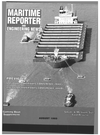
Page 26: of Maritime Reporter Magazine (August 1993)
Read this page in Pdf, Flash or Html5 edition of August 1993 Maritime Reporter Magazine
Bayou La Batre, Alabama
Area Maritime Companies Look To Channel
Deepening, Market Diversification
T oday, the industries of Bayou La Batre are again caught in the riptide of change. A general decline of the shrimp industry has caused an increased move toward diversi- fication into construction of varied commercial vessels and increased foreign marketing. Even though the total number of boats being constructed here is significantly down from previous years, the probability is that Bayou La Batrians will evidence their traditional bouyancy and add to local industries the ingredients which will result in bouncing back to greater heights of success.
The riptide in which Bayou industries find themselves today is one made up primarily of market changes rather than internal problems.
However, environmental protection demands and other operational costs do pose serious problems to builders that must be overcome.
Evidence of the industry's reaction to change is seen in the degree to which almost all have in- creased activities aimed at garnering an increased share of foreign markets, updating tools of the trade (primarily through computerization), and a shift to such types of vessels as tugs, oil industry support and passenger vessels.
The modern age Bayou La Batre boatbuilding and sales record is an exact reflection of world- wide economic and political changes paced by developments of new fishing areas and catch volume within existing fishing areas. From the assembling of an entire fleet of fishing vessels for export to Vietnam at the beginning of the war there, to the recent outreach to Russia, boatbuilders have exploited opportunities as they have presented themselves. The record mirrors
African and Central American modernization of fishing fleets and includes such far-flung places
By
Vincent Bosarge and Harold Larimer as Somalia and India which have become home port to bayou-built boats.
Channel Deepening Equals Market
Expansion
With a channel deepening from 12- to 18-feet soon a reality, Bayou La Batre's shipbuilding and related industries are beginning to specu- late as to what must be done to take advantage of the deeper channel, which, for the first time, will afford access to many types of ocean-going vessels.
The shrimp industry, mainstay of the city's economy almost since it was founded more than 200 years ago, has declined steadily since 1975 when it was not unusual to see more than 400 boats lining the Bayou, waiting to unload their catch. Today, according to city councilwoman
Vickie Robertson, you're lucky to see 40. In 1992, shrimp landings at Gulf of Mexico ports were down more than 14 million pounds from 1991.
In the mid-80s shipyards in Bayou La Batre, anticipating the downtrend in the shrimp in- dustry, began a diversification program which has helped stave off economic collapse. Still prohibited by the shallow 12-foot channel, Bayou shipyards, noted for a favorable labor supply, skilled craftsmen and reasonable wage scale, hope that once the channel is deepened fleet and vessel owners will find them an attractive alter- native for economical repair and construction.
The area's availabilty as another Gulf Coast port cannot be overlooked either, especially with recent rapid growth of the offshore gas industry
Chicago's First Lady, a 96-foot pleasure boat built by Steiner Shipyard.
Stern Dragger built by LaForce Shipyard. which requires large quantities of supplies and building materials. These gas fields are within minutes travel time from the mouth of the chan- nel.
The city, with its 14 shipyards, stands poised for an economic shake-up.
To learn more about their plans and what they have in mind for replacing a falling industry,
Maritime Reporter & Engineering News sent
Vincent Bosarge and Harold Larimer to re- visit the city that was featured in the May 1991 issue of the magazine.
At S&S Marine Repair, Inc., a newcomer to the
Bayou, Carolyn Overstreet, operations man- ager, and Daryl Steiner, yard superintendent, are optimistic about the future. They are in the process of upgrading and increasing the capacity of the yard's two haul-out railways in anticipa- tion of an increase in repair and conversion jobs the 18-foot channel will bring. Since opening the yard in 1992 they have established a reputation for quality conversions, a good example being the "Beacon," a 105- by 24- by seven-foot research motor vessel, which was converted to a treasure hunting ship.
The Bayou's reputation for doing conversions is not just local. When Mr. Frank Goto, manager of United Fishing Agency, Ltd., in Hawaii, learned that buyers from Majura in the Marshall Islands were looking for used shrimp boats to convert for their own ocean-going needs, he directed them to the Bayou. Being a satisfied customer of long standing, he knew exactly where they would be able to find not only the boats, but skills required for the conversions. S&S Marine Repair, Inc. accomplished two of the conversions, one for Mr.
Sam Leon and another for Mr. Charles
Dominick. Two local Bayou boats, "Revenge IV" and "Tami Darlene" became the "Samantha" and "Charlie's Angel."
According to Daryl Steiner, the deeper chan- 28 Maritime Reporter/Engineering News

 25
25

 27
27
